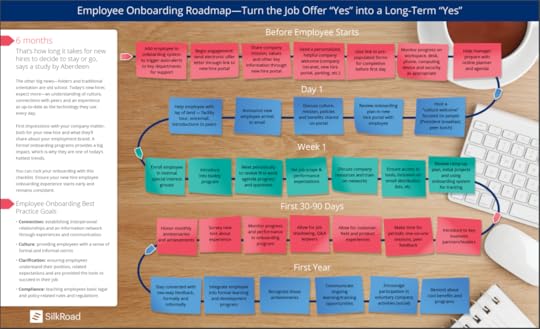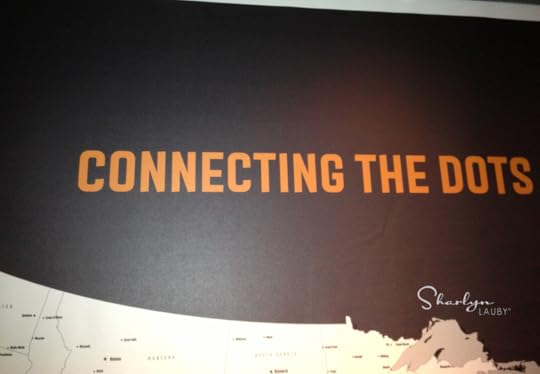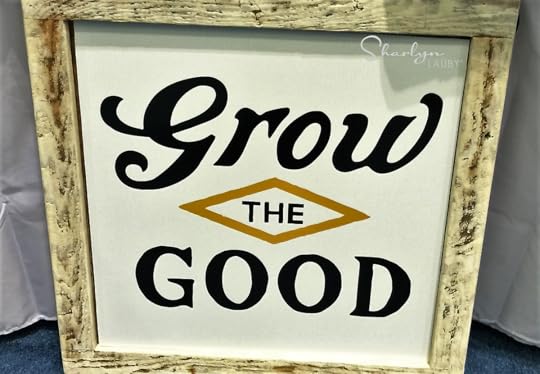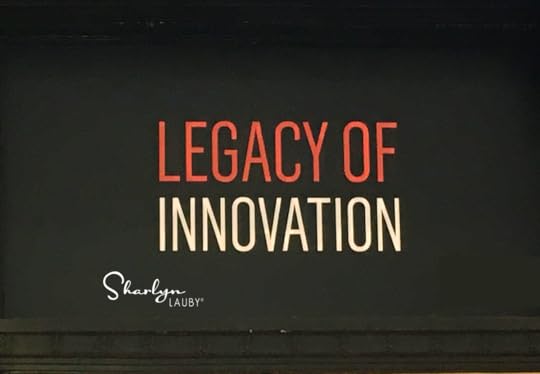Sharlyn J. Lauby's Blog, page 130
September 21, 2017
How to Create the Perfect Morning Routine
I stumbled across an article recently in Training Magazine about “Creating a Continuous Learning Culture”. We’ve talked before about self-learning being a competency that individuals should develop. The thing I found interesting in the article was the focus on daily rituals. The idea being that employees should learn how to develop daily rituals that will help with their learning.
When I think of daily rituals, the first thing that comes to mind is my morning routine. I’ve always felt it’s easy to have my day slip away from me; so, if I could take control of my morning routine, then that’s a win. This means I have a tendency to put a few pieces of self-care in my morning routine. I work out in the morning. I like to read in the morning.
If you’re looking to start a new morning habit (or know someone who should), SkillShare has a class on how to “Create a Perfect Morning Routine”. You can watch it for FREE from your Facebook account.
Getting a good start to the day can help you be your best and do your best work. But like so many things, if you want it, you should find time for yourself.
Jeff Finley, the class instructor and author of the book “Wake Up: The Morning Routine that Will Change Your Life”, encourages viewers to take the time to clearly establish the reason you’re doing it. You have to care about something that is causing you to focus on your morning routine. Whatever it is, write it down. Put it on your refrigerator. Keep it in your planner. Make it your computer or phone screensaver. Whatever it takes to keep you focused and dedicated.
5 Steps for Creating a Morning Routine that Works for You
I believe the key to successfully creating any type of routine is figuring out what works for you. Honestly, it might not happen right away. You can use other people’s suggestions as a starting point. Some might work, others not so much. In the class, Finley focused on five steps:
Step 1 – Make getting up fun. I don’t want to say get up at a specific time. Think of this more as the way you get up can have an impact on your day. Create a sense of excitement about the start of the day. One way to do that is going to sleep knowing what you’re going to do the next day. It could be binge watching your favorite TV show, having your favorite beverage or breakfast, or reading something you enjoy.
Step 2 – Develop a routine. There are obviously things you’ll do every day. You’ll want to figure out what those are (i.e. meditation, journaling, reading, showering, eating breakfast, exercise, etc.) But there might also be things you do on a particular day of the week. I’m hearing about people adopting activities like “Bucket List Monday” where they do something they’ve always wanted to do. Or maybe a “Fun Friday”.
Step 3 – Include learning in your morning routine. This aligns with the continuous learning culture I mentioned at the beginning of the post. Do something to stay curious and keep learning – listen to a podcast, read a book, or try an activity. You can also use this time to write in a career journal. Since we’re talking about morning routines, it might be necessary to keep learning activities to the ones you can do by yourself (unless you have a couple of friends who are early risers).
Step 4 – Practice self-awareness. This can be done through meditation, mindfulness, or deep breathing. It doesn’t have to take a long time. You’ll be amazed how a few moments each day can increase your self-awareness. This could also be a good time to think about gratitude. Take mental note of the things you’re grateful for or your priorities. Shawn Achor’s TED talk includes some insights on gratitude journaling.
Step 5 – Find time for exercise. It seems logical to me that there’s a connection between waking up your body and waking up your mind. And no one is saying you must go to the gym. I know some people enjoy taking a Pilates class after work or SoulCycling during their lunch. Mornings could be for light exercise like a walk or just some stretching. For me, it’s walking on my treadmill desk and cycling on my Cubii.
Make the Commitment to a Better Morning
Developing any kind of routine takes time. Do what works for you. Put it on a piece of paper. Attach times to it. Want to spend 30-minutes exercising? Put it on the list. Want to binge listen to the STown podcast each morning? Gotta budget the time. Start by setting a small goal: try to do your morning routine for a week. Then for two.
One other thing that the class didn’t mention but I want to. I find that duplicating my home morning routine is difficult when I travel for business. So, I have a slightly different routine when I travel. I look forward to it when I’m on the road and I look forward to my home routine when I’m back. Same with vacation. It keeps the guilt away because I’m still committed to a routine.
Lastly, once you make a commitment to a routine, communicate with the people in your life. It’s possible that your morning routine will impact others. You don’t want them to sabotage your reasons for doing this. Let them know why it’s important and ask for their support. Ultimately, your self-care is better for them as well.
Image captured by Sharlyn Lauby after speaking at the SHRM Annual Conference in Las Vegas, NV
The post How to Create the Perfect Morning Routine appeared first on hr bartender.






September 19, 2017
How to Assess Your Company’s Onboarding Program

Click to View Larger Version
(Editor’s Note: Today’s post is brought to you by our friends at SilkRoad , a provider of talent activation technology. Be sure to check out their “ Top Sources of Hire 2017 ” report, which lists the top seven sources of new hires. It’s a must-read for any talent acquisition professional. Enjoy the post!)
Regardless of what we call it, we know what onboarding is. It’s the process new hires (or newly promoted employees) go through to become productive. The question becomes do organizations know how well onboarding does for them? There’s only one way to find out the effectiveness the company’s onboarding process. That’s by conducting an assessment.
Today’s post is designed to provide an outline for assessing your onboarding program. I hope you’ll bookmark this page for future reference and use it to regularly evaluate your program’s effectiveness.
4 Steps for Assessing Your Onboarding Program
During a program assessment, there are four areas that organizations need to examine: objectives, content, employees, and managers. Let’s talk about each of them.
Remember goals and objectives. Companies want to ask themselves, “What’s the purpose of our onboarding program?”. We’re not talking about the definition of onboarding here. The purpose of a company’s onboarding program might be a little different in each organization. Meaning the purpose could be to “make new hires productive and…” It might include a compliance component. Or some sort of socialization piece. The objective might also mention pre-boarding and orientation.
Organizations might want to consider reviewing program goals and objectives once a year. Make it a part of the budget development process, in case you need to request resources to grow or improve the program.
Evaluate the content. Think about the program materials from two perspectives. First, is the content current? I am sometimes amazed that companies implement new policies and forget to update training programs as part of the roll-out. Companies should have a process in place so onboarding content doesn’t become outdated. Make sure that the person or department responsible for updating content is provided with the information they need. The second aspect is to review the content to ensure alignment between the program goals and the content. It doesn’t necessarily mean the content needs to be changed, but it could mean that the sequence does.
If you schedule onboarding sessions regularly, keeping the content current might not be an issue for you. But if you only conduct onboarding activities quarterly, it might make sense to build extra time into the program schedule for a content review prior to each time it’s delivered.
Survey employees. New hires have a fresh perspective on everything. This is a great opportunity for feedback. Ask employees if they feel the organization is making an investment in their future. Onboarding should send that message.
I’m a fan of surveying new hires after orientation, after their introductory period, six months and one year. You can use a combination of techniques such as online surveys, focus groups, and one-on-one meetings. Find out if employees feel they are getting the information they need at the moment they need it. Onboarding isn’t supposed to be a surprise. Companies might want to provide new hires with an onboarding roadmap to set expectations.
Survey managers. Trust me, managers have an opinion about the onboarding process. They have a first impression of the new hire when they arrive to the department after orientation. Is the employee excited and enthused or deflated? Mangers will also have some insights about the new hire’s performance after their introductory period.
Find time to have regularly scheduled one-on-one meetings with managers to talk about talent. This conversation should focus on recruiting, onboarding, training, etc. Ask managers if they feel employees are coming to the department prepared? Share with them a copy of the employee’s onboarding roadmap. They should know the contents and support it. And speaking of support, make sure that managers have all the resources they need to continue the process after company orientation. Ask what help or assistance they need from HR.
Regular Reviews of Onboarding Keep the Program at its Best
Even though I included the word “assessment” in the title, I know sometimes labeling something an assessment can be a negative. These activities don’t have to be labeled “assessments”. Just make it a practice. The organization wants to know that onboarding is doing what it’s supposed to do. Because getting it right means that employees are set up for success.
And if you want to learn more about setting employees up for success, join me and the SilkRoad team on Thursday, September 28 at 1p Central / 2p Eastern for a webinar on “How Organizations Can Create a Personalized Onboarding RoadMap for New Hires”. Registration details can be found on the SilkRoad website. Employees want to feel like they’re more than ‘just a number’ when they start. The way to accomplish that is by creating a strategic onboarding program that make new hires feel they are going to be successful.
The post How to Assess Your Company’s Onboarding Program appeared first on hr bartender.






September 17, 2017
Managers Should Spend the Majority of Their Time Doing This
I’ve said on multiple occasions that a manager’s job is to hire and train their replacement. Not only does that allow managers time to step away from their devices and take a vacation, but it allows them time to develop themselves.
The key to hiring and training your replacement is delegation. It’s knowing what to delegate and when.
Managers need to create a connection between learning, goals, performance, and the business. And they need to communicate that connection to employees. Here’s how the four are linked:
LEARNING – My guess is that most businesses do not operate the same way they did a decade ago. Technology has changed payment processing. There are new products and services. Because business has changed, it only makes sense that employees need to learn new processes. Managers should support employee efforts to regularly learn new knowledge and skills.
GOALS – I believe the process of learning something new is a form of goal. When I make the statement, “I’m signed up for a MOOC on gamification.”, in effect, I’m saying I want to learn something. Once I take the course, I might leave with a list of to-dos such as read Kevin Werbach’s book “For the Win: How Game Thinking Can Revolutionize Your Business”. Managers should help employees continue their learning experience by encouraging goal-setting.
PERFORMANCE – If employees are successfully doing #1 and #2, higher levels of performance should follow. I’m using the words “if” and “should” for a reason. Many times, companies say they support employee learning, but…they really don’t. And many times, employees say they’ve set goals after learning, but…they really didn’t. This is one of those moments where there’s a difference in saying the words and actually living them.
BUSINESS – Higher levels of employee performance do have a direct impact on the bottom-line. High performing employees work smarter, which increases productivity and quality. Customers definitely see the benefits of a high performing workforce. The company is rewarded with customer loyalty, increased market share, and finally, better sales revenue. Managers should look for opportunities to recognize and reward employees for their efforts.
As part of their job to “hire and train their replacement”, managers should create this connection. They won’t be able to delegate if employees don’t know what to do. Employees need to understand why it’s in their best interest to learn something new (i.e. What’s the WIIFM?). Managers should be comfortable giving employees control, power, and authority over the tasks they are responsible for.
I was listening to a presentation the other day where the speaker said, “There’s a difference between staying in the same job for ten years and being challenged for ten years.” It’s so true. An employee can be in the same job for years and be challenged – Every. Single. Day. That’s the role a manager plays in the organization. They create that level of challenge by connecting learning, goals, performance, and the business.
Organizations should ask themselves if managers understand their role. More importantly, organization should ask themselves if they’re giving managers the training and tools to do this.
Image captured by Sharlyn Lauby after speaking at the Massachusetts Women’s Conference in Boston, MA
The post Managers Should Spend the Majority of Their Time Doing This appeared first on hr bartender.






September 15, 2017
5 Business Lessons Learned from Adult Dot to Dot Books

Move over adult coloring, the new stress reliever is dot to dot.
You remember dot to dot books, right? There’s an image and you must connect the dots in sequence to draw in the lines. I’ve started seeing articles about the emergence of adult dot to dot books, both as an alternative to adult coloring and in addition to.
 So, I decided to try this and bought Dot to dot for Grown-ups by David Woodroffe. I purchased a copy for less than $10 and it has over 100 puzzles including landmarks of the world, iconic buildings, classic vehicles, works of art, the animal kingdom, and iconic scenes from history and literature.
So, I decided to try this and bought Dot to dot for Grown-ups by David Woodroffe. I purchased a copy for less than $10 and it has over 100 puzzles including landmarks of the world, iconic buildings, classic vehicles, works of art, the animal kingdom, and iconic scenes from history and literature.
While I was test driving dot to dot, I learned a few things that I wanted to share. Not only about the dot to dot activity but great business reminders.
Mindfulness is important and takes different forms. I’ve talked about my fascination with mindfulness several times. I’m often frustrated that I just can’t get into guided mindfulness sessions. But dot to dot has made me realize mindfulness is a personal thing. The important part is to find a way to practice mindfulness that you can embrace. Whether that’s deep breathing, guided sessions on your smartphone, or dot to dot books.
Counting provides a good thinking exercise. This book isn’t a counting dot to dot up to the number 10. The counting goes up to 400. You can download pages from the internet that go much higher. Some of the puzzles were combinations of numbers and letters. So, you do have to think a little, but not think so much that it creates stress. It was a good reminder for when I’m focusing on a project to stay calm.
Stay in the present, but remember to keep looking forward. Dot to dot requires you to not only look at where you are right now in creating the image, but where’s the next number. If we assume that we know the direction of the next number and we’re wrong…well, we have to dig out the eraser. Or if we were confident that we couldn’t possibly make a mistake, then we have a wrong line in our drawing and must figure out how to deal with it.
Sometimes the answer is right in front of you, but you can’t see it. This happened to me with the first dot to dot puzzle. I finished the connecting the dots, but I didn’t see the image right away. It took me a few moments to come into focus. This happens in business all the time. We have to remember to keep looking until we find it. And sometimes, we might need others (who do see the image) to help us.
There’s more than one right way of doing things. Some people will love dot to dot and others will go back to adult coloring. And I’m sure there are a few people who think both are silly. The point is all of us should find ways to relieve stress and have a little fun. Find what works for you. There’s a way to share ideas without passing judgement. We should let employees find their right way of doing things.
Every single day in our professional lives we’re asked to see the plan, think, focus, and consider the future. We want to be ourselves. And we should let others do the same. I’m enjoying my dot to dot book and the lessons it’s teaching me.
Image captured by Sharlyn Lauby at the Mob Museum in Las Vegas, NV
The post 5 Business Lessons Learned from Adult Dot to Dot Books appeared first on hr bartender.






September 14, 2017
Should Employees Receive an Auto Allowance – Ask #HR Bartender
At first glance, this might seem like a unique situation. But employees sometimes get asked to use their personal vehicles to run errands or drop stuff off at another location all the time. Today’s reader note is about how employees should be paid for mileage.
I live in Florida and am a construction superintendent. Part of my job involves traveling between job sites to pick up/drop off supplies as needed. I use my personal vehicle to do this. I pay all the expenses: gas, tires, maintenance, and insurance.
The company puts business magnets on my truck. Over the years, I’ve told the company that I’m using a lot of gas. So, they will occasionally throw me a credit card for a tank of gas and then talk down to me saying that I don’t know how to manage my money. To better keep track of my expenses, I recently downloaded a mileage app on my phone. I discovered that I’ve been driving an average of 245 business miles/week on my truck. When I showed the company, they changed my pay stub to include a $56 allowance/week for fuel, which is being taxed as part of my income. This doesn’t come anywhere near what I actually spend!
There is no policy in the employee handbook regarding travel. The other employees stay on one job site and don’t travel as much as I do. Do I have any rights?
I’ve mentioned before that it can be difficult to directly answer reader questions. But this note does prompt a lot of good questions about auto allowances. To help us understand more, I asked Chad Raymond, vice president of HR at Paycom, to share his experience. Chad has over 19 years of experience in employee engagement, benefits administration, and government compliance. He’s worked in several different capacities within Paycom including leading their product development team and HCM initiatives. He also served as the director of Paycom’s service department.
Oh, one more thing. I know you guys know this but please remember that Chad can’t possibly cover every contingency in this article. The information we’re covering is for general informational purposes only and does not constitute legal advice, tax advice, accounting services, or professional consulting of any kind. It’s always a good idea to discuss specific detailed situations related to this matter with your friendly professional tax, accounting, legal or other professional services consultant.
Chad, let’s start by sharing what a written auto allowance policy might look like.
 [Raymond] Having a written policy about auto allowance and reimbursements can benefit employers and employees, and an ‘accountable plan’ can help reduce tax liability on both ends.
[Raymond] Having a written policy about auto allowance and reimbursements can benefit employers and employees, and an ‘accountable plan’ can help reduce tax liability on both ends.
An accountable plan is a written policy that allows reimbursements to not be counted as an employee’s taxable income. Timely reimbursement interactions help the Internal Revenue Service (IRS) determine that a reimbursement is under an accountable plan and potentially not taxable.
Setting a written policy outlining those timeliness requirements can ensure most of your reimbursement interactions would occur within the accountable plan timelines, and the IRS would be able to count them as not taxable income. Utilizing an expense management system can make this process smoother for both employees and employers.
Let’s get granular. Specifically, what does an auto allowance cover, and is it taxable income?
[Raymond] An auto allowance is the repayment of expenses incurred by an employee while using a personal vehicle for work purposes. Whether that income is taxed or not depends on certain criteria.
Section 61 of the Internal Revenue Code (IRC) defines gross income as all income, no matter where it came from. Section 62(a) defines adjusted gross income as the income of Section 61, minus certain deductions. Section 62(a)(2)(A) notes that an employee may deduct certain business expenses they have made during the course of their work under a reimbursement or other expense allowance arrangement when determining adjusted gross income.
If a reimbursement meets the requirements of business connection, substantiation, and returning excess reimbursements, all reimbursements would fall under the accountable plan and may not be taxable income. Section 62(c) states that income will not be treated as a reimbursement (or under another expense allowance arrangement) if (1) the arrangement doesn’t require the employee to substantiate their expenses, or (2) the arrangement allows the employee to keep any reimbursement that exceeds the amount of the substantiated expenses.
Reimbursements that do not meet the accountable plan’s requirements will be considered under a non-accountable plan. Reimbursements under a non-accountable plan will be considered taxable income.
What are the pros and cons of auto allowances – for the company and the employee?
[Raymond] An auto allowance policy that ensures reimbursements fall under an accountable plan can benefit employees and employers.
Reimbursements that fall under an accountable plan do not count toward an employee’s gross income. That income is exempt from withholding and payment of employment taxes, and is not reported on the employee’s W-2. The employee receives a lower taxable income, which reduces his or her adjusted gross income, affecting the 2 percent deduction floor.
An employer will not be liable to pay employment taxes on those reimbursements, as long as they fit the accountable plan requirements.
The drawback to having an accountable plan is the manual processing required by the employee and employer to ensure that reimbursements fit the criteria.
If an employee feels their auto allowance isn’t sufficient, is there something they can do?
[Raymond] Yes, if an employee is spending more than the employer will reimburse, the employee should retain any relevant records as part of their tax records and can then claim credit for those unreimbursed expenses by filing Form 2106 (Employee Business Expenses). A mileage tracking app can help ensure accurate and efficient record-keeping.
I want to extend a huge thanks to Chad and our friends at Paycom for helping us with this article. As you can see from Chad’s comments, what might seem like a simple employee benefit can be very complex. Both for the organization and the employee.
Asking an employee to run a quick errand or drop off something at another location might not seem like a big deal at the time. And employees might be very willing to do it. But it can quickly become a gripe if it’s abused OR if it’s not compensated properly. Organizations need to do their homework and make sure employees are being paid for the work they do and reimbursed for the expenses they incur.
P.S. If you’re reading HR Bartender via email or an RSS Reader, I hope you’ll take a moment to click through to our new site. To celebrate nine years of blogging, we wanted to update our look. Thank you for reading, commenting, and sharing HR Bartender. We truly appreciate you. Cheers!
Image captured by Sharlyn Lauby while cruising down Seven Mile Bridge heading to beautiful Key West, FL
The post Should Employees Receive an Auto Allowance – Ask #HR Bartender appeared first on hr bartender.






September 12, 2017
The $100,000 Bill: ALL Labor Law Changes Impact Your Bottom Line
(Editor’s Note: Today’s post is brought to you by our friends at Kronos , a leading provider of workforce management and human capital management cloud solutions. The Boston Business Journal has recognized Kronos as the 5th Healthiest Employer in Massachusetts and BostInno named them one of the 10 Coolest Companies to work for. Many congrats! Enjoy the post.)
The human resources function is often criticized for spending too much time focused on compliance. The reality is compliance is an important part of the HR function. It’s also expensive.
A new survey from The Workforce Institute at Kronos and Future Workplace indicates that it can cost organizations as much as $100,000 each time a federal, state, or even local labor law is created or changed. And if you’re thinking to yourself, “That’s exactly why we need fewer labor laws!”, well…you could be right. But that’s only from a maintenance perspective. It doesn’t reduce the cost of changing the law. Organizations have to use just as many resources when a law changes.
We could debate all day whether or not a piece of legislation is necessary. That’s not the point. There will always be multiple sides any time a labor law changes. The real takeaway here is that the task of implementing a policy based on a piece of legislation is complicated, challenging, and costly. Malysa O’Connor, senior director of SMB market development at Kronos, says the key is balancing multiple business responsibilities. “As the survey demonstrates, human resources and payroll professionals at organizations of all sizes want to ensure compliance to the fullest of their abilities, but often struggle because of the constant and rapid nature of the changes.”
How a Labor Law Impacts Your Bottom Line
When organizations are faced with implementing new legislation, costs arise in multiple areas. Obviously sometimes there are direct costs, like a minimum wage change. Then there’s the time that it takes to research the new legislation, change existing policies, and educate the company. Finally, there are costs associated with developing recordkeeping and administrative procedures to maintain the new requirements. Survey respondents shared some eye-opening insights about labor law compliance:
It’s complicated. There’s no one-stop resource to keep up with regulatory changes. Over half of respondents (59%) said they rely on their HR/payroll software provider to learn about changes. Other resources cited include industry associations (39%) and legal counsel (37%).
It’s challenging. We know it’s hard to recruit and it’s not getting any easier. Nearly two-thirds of respondents (58%) reported that they’ve witnessed colleagues occasionally cut compliance corners. Sixty-four percent (64%) say that they expect compliance to be even more challenging under the current administration.
It’s costly. More than two-thirds of survey respondents (68%) said that compliance is more expensive than last year. Three-quarters of respondents (74%) said it’s more expensive than 2007. What’s interesting about these numbers is that, in organizations with less than 500 employees, 20 percent can’t identify the annual cost of being compliant.
While these numbers aren’t comforting, I don’t believe the answer is for HR to minimize the importance of their compliance role. In fact, it’s quite the opposite.
HR’s Role in Managing Compliance
HR needs to play an active part in managing compliance. Because when that happens, HR has a direct impact on the bottom-line. So, what can HR professionals do? Here are three things to consider:
1. Be ready to talk numbers with your senior management team. When new legislation is enacted (or even being considered), the first question senior management asks is “How much is this going to cost us?” Think about the last labor law you had to deal with (i.e. changes to the Fair Labor Standards Act) and what was involved. Put an estimated dollar amount on it. At least that way you can say, “Here’s what this law cost us…”.
This is also a great time to partner with the finance department. Get their insight about what a legislative change means to their function. Together, HR and finance can present not only the costs but a proposed plan to address the change.
2. Discuss the pros/cons of getting involved with legislative advocacy. More businesses are realizing the need to have their voices heard when it comes to government advocacy. I remember years ago working for the airline when a proposed fuel tax was going to impact our business. Not only did the company make their feelings about the tax known, but employees contacted their legislators as well.
Human resources professionals can become members of the Society for Human Resource Management’s Advocacy Team (aka SHRM A-Team). SHRM posts public policy information and provides an easy way to contact legislators. Business professionals can also check with their industry associations and Chambers of Commerce.
3. Find a strategic technology partner. Organizations can use technology to ease the burden of change. While HR plays a key role in compliance, it doesn’t mean they need to manage it by hand. This is when technology gets to do what it does best, so HR spends more time on face-to-face interactions.
Yes, technology helps with administration. But an excellent technology provider does so much more. Cloud solutions and highly configurable systems do more than risk avoidance. They bring direct value and can enhance the candidate and employee experience. While we have to be compliant, we don’t have to make it a negative experience.
Labor Law is Always Changing and We Have to Change with It
Fortunately, and unfortunately, the law is always changing. But this doesn’t mean that HR and the business always have to be burdened with administration. Organizations can create an internal infrastructure that manages compliance efforts with the help of technology.
To get more information about how HR departments can manage compliance more effectively, check out the full “$100K Bill” report on the Kronos website. We will always have to deal with compliance. But, with a little help and planning, maybe we can manage it more effectively.
The post The $100,000 Bill: ALL Labor Law Changes Impact Your Bottom Line appeared first on hr bartender.






September 10, 2017
INTERVIEW: Dr. Jac Fitz-enz on Human Capital Metrics
I’m a self-professed math geek. Which is why I’m very excited to share with you today’s interview. But before we start, I want to share how I learned about Dr. Jac Fitz-enz. I’ve told this story before but I’m going to tell it again.
In my very first human resources manager role, I attended a weekly department head meeting. My boss would have all of us go around the table, talk about the projects we were working on, and discuss any resources (i.e. budget and staff) we needed to achieve our goals.
The operations director would talk about their projects and the resources they needed – and they would get them. Then the marketing director would do the same. And the controller would too. All of them would get the resources they requested. When it came time for me to talk about projects and needs, sometimes I would get what I wanted and sometimes I didn’t. Frankly, it was frustrating. I was determined to find out what they were doing that I wasn’t.
Then I realized that, when my colleagues talked about projects and resources, they talked in terms of return-on-investment (ROI) and the bottom-line. I talked about what made the employees feel good. That’s not to say employee satisfaction isn’t important. But I found that, when I turned employee satisfaction into a number…I got what I wanted too.
I learned how to turn stories into numbers by reading a book – “How to Measure Human Resource Management” by Dr. Jac Fitz-enz. In addition, two of his books, “Human Value Management” and “The ROI of Human Capital” won the Book of the Year Award by the Society for Human Resources Management (SHRM). I had the opportunity to chat with Dr. Jac about his career and how human capital impacts today’s human resources departments. I’m thrilled to share his thoughts with you.
In 1977, you founded the Saratoga Institute (SI), which is well-known for its work in human capital metrics. What prompted you to start the Institute?
 [Fitz-enz] I first became involved with HR, then called personnel and training, in 1969. I found a function that was regarded as a cost center that created no value. Having come from the sales and marketing side I couldn’t accept that a company would support a nonvalue generating unit. So, I started working on a way to measure and evaluate in objective terms the work of HR. It took until 1977 to work out and test the system. Then I was ready to take it public through SI.
[Fitz-enz] I first became involved with HR, then called personnel and training, in 1969. I found a function that was regarded as a cost center that created no value. Having come from the sales and marketing side I couldn’t accept that a company would support a nonvalue generating unit. So, I started working on a way to measure and evaluate in objective terms the work of HR. It took until 1977 to work out and test the system. Then I was ready to take it public through SI.
The initial response was quite negative. It took about 10 years before the function began to accept it. HR people were not business oriented and were afraid that revealing the results of their work would make things worse for them. Only by showing them how to evaluate improvements in staffing, compensation, development, and retention in terms of cost reduction, process times, quantity produced, quality of the outcomes and reactions of the company’s management and employees did they begin to come around.
Lots of talk today about predictive analytics. In fact, you co-authored a book titled “ Predictive Analytics for Human Resources ” with John Mattox. Is there a place in HR for both metrics and analytics? If so, how should HR professionals approach it?
[Fitz-enz] HR is a business function just like sales, operations, IT, etc. Therefore, it should be managed like a business and its performance measured accordingly. There are three levels of analytics:
Descriptive. Measurement is descriptive. It tells WHAT HAPPENED in a past period; month, quarter, year, etc. This is what accounting reports—the past.
Predictive. By referring to the past (descriptive metrics) and studying the future we can determine WHAT TO DO to produce more positive results in the future; i.e.; prediction.
Prescriptive. Finally, prescription is a plan of how to carry out the prediction leading to the desired result. It’s like a doctor’s prescription that tells us to take a certain number of pills over a certain time period to overcome the illness (the prediction). It is the HOW to do it.
HR professionals are busy today. If they only had time to focus on a handful of metrics, which ones should they consider?
[Fitz-enz]Attraction and retention of qualified talent seems to be the biggest concern of management. Therefore in most cases, retention is a very valuable metric. By sorting it by job level, length of employment, and possibly effects of processes such as new hire orientation, supervisory skills, training, etc. you can begin to manage it.
Training Effectiveness is also very valuable. ROI Institute has developed a very effective method for measuring training program outcomes and effects.
Beyond that, HR should focus on how it is attempting to support business initiatives such as time to market, cost reduction, productivity, and customer retention. The question is, how are we contributing to those strategic business objectives?
A new trend emerging in HR is departments starting to hire their own analysts. Any thoughts on this? What do you see as the pros/cons?
[Fitz-enz] If the budget allows it I believe it is best to have HR analysts on staff. This way, their time and efforts can be directed and controlled. Also, they should build relationships with analysts in finance, marketing, and IT. Both sides will benefit from this coordination.
How can HR sell senior management on the value of metrics?
[Fitz-enz] Management wants to know to make the business more productive, produce higher quality, and optimize customer retention. If HR can focus its efforts on working with line management to contribute to those strategic goals and demonstrate it in quantitative terms, management will appreciate HR and support it. My experience is that HR spends too much time looking at its services and not enough on connecting them to the business goals.
I know you’ve recently retired and turned your talents toward writing fiction. Want to share with readers your new project?
[Fitz-enz] I’m writing a series of adventure and romance novels titled the Mike and Grace Novels under the pen name DOCTOR JAC. It focuses on the activity and relationship of a young naval intelligence officer and his brilliant Chinese/American partner and wife. (She is a special agent of the State Department assigned to work with him.)
In the first book, “Undaunted Lovers” they meet and fall in love, but she’s married. The story is how they struggle with that until the last chapter that is a happy ending.
Second book, “Spies with Benefits”, starts one minute after the end of Undaunted Lovers. In this, they eventually marry and take off on a series of clandestine assignments involving recruiting spies for the US, solving a murder, catching a spy, then foiling a diplomat’s kidnapping, and stealing weapon plans in Beijing, China. The books are available on AMAZON and Barnes and Noble.
In the next book, “London’s Secrets”, they’re working in the UK and Luxembourg.
A big thanks to Dr. Jac for taking time to share with us his experience and expertise. If you’re looking for the HR book that will help you take your metrics and measurement to the next level, go buy one of his. And if you’re looking for something lighter to read by the pool, grab one of his new novels.
HR and measurement go together. But we don’t have to learn the HOW alone. There are lots of great resources to help us.
Image taken by Sharlyn Lauby at Boston Logan Airport following a Workforce Institute board meeting.
The post INTERVIEW: Dr. Jac Fitz-enz on Human Capital Metrics appeared first on hr bartender.






September 8, 2017
Bookmark This! Your Fall Business Reading List
Summer is winding down. The kids are back in school. And fall conference season is right around the corner. I don’t know about you, but I tend to read more fun, lighthearted books during the summer months. Then I break out the business books in the fall.
So, I’ve been looking for recommendations for my business book list. Personally, I think I’m off to an awesome start. Here are a few books I have set aside:
“The Pivot” by Lori Michele Leavitt. This book focuses on helping leaders drive organizational change and achieve momentum. I can’t think of a more timely subject. Organizations and their leaders are being asked to pivot constantly. Sometimes by design. Other times because it’s necessary for business survival. One of the things I like about this book is that it includes a Pivot/Aligned Momentum Assessment.
“Humans@Work” is a compilation of essays from human resources professionals on the value of people in the workplace. It includes writing from a couple of my favorites – Jeff Nally and Shelly Trent. And when you purchase this book, a portion of the proceeds benefit the SHRM Foundation, the research arm of the Society for Human Resource Management (SHRM).
A few months ago, I interviewed Pandit Dasa about leadership and mindfulness. We met in person during the WorkHuman Conference (pioneered by Globoforce) and he was very kind to give me a copy of his book, “Urban Monk”. And yes, this book is about exactly what the title implies, being a monk in New York City. I’ve been looking for the perfect moment to start reading this one and I believe up at 37,000 feet without any mobile devices will be the place.
Now, I must admit that I rarely re-read books, but one I’m planning to read a second time is Steve Browne’s “HR on Purpose”. Steve is the executive director of HR at LaRosa’s Pizza and a SHRM board member. I had the opportunity to read Steve’s book prior to publication. Now, that’s it’s been on the bookstore shelves for a few months, I’m going to pick it up again. This book is focused on everyday human resources and how to be engaged with the profession.
I think my reading list will keep me busy for a while. I’m curious. What’s on your fall business reading list?
Image captured by Sharlyn Lauby at the Bellagio Conservatory & Botanical Gardens in Las Vegas, NV
The post Bookmark This! Your Fall Business Reading List appeared first on hr bartender.






September 5, 2017
Organizations Can Use Assessments to Bridge the Skills Gap
(Editor’s Note: Today’s post is brought to you by our friends at Criteria Corp , a leading provider of pre-employment testing services. They recently launched an app called JobFlare (iOS, FREE) that allows users to play “brain games” that are scientifically created to test the cognitive abilities that are considered the key predictors of job success. Enjoy the post!)
According to the Society for Human Resource Management (SHRM) report “The New Talent Landscape: Recruiting Difficulty and Skills Shortages”, 68 percent of HR professionals are having trouble recruiting candidates for full-time positions. In addition, more than half say that the reason is candidates don’t have the skills for the jobs they’re applying for.
This skills gap is causing businesses to turn down projects because they don’t have either 1) enough talent to do the work or 2) the right talent to make it happen. The Association for Talent Development (ATD) released a white paper on Bridging the Skills Gap and reported that 87 percent of organizations felt the skills gap was impacting customer service delivery and business growth.
At some point, organizations need to realize that they must make an investment in employee training and development to get the talent they’re looking for. Obviously, turning away business isn’t the answer. And waiting for someone to apply with the perfect resume is probably not feasible either.
Organizations Can Use a 3-Strategy Approach to Recruitment
We’ve talked before about using a 3-strategy approach to recruitment: Buy, Build, and Borrow.
BUY is where the company hires talent from the outside. The advantage to this approach is that the organization gets fresh perspectives and new ideas. The disadvantage is that it can be expensive to attract good talent from the outside.
BUILD is when the company develops talent from within. The upside is that this strategy is great for employee morale. The downside is that developing talent takes time. It also means having the training resources available.
BORROW is using freelancers or consultants when the need arises. Not every job is a full-time job, so the pro to this approach is getting the necessary talent at the moment it’s needed. The con is keeping freelancers engaged so when you need them, they’re available for you and ready to work.
While I’ve presented these strategies separately, organizations don’t have to utilize these three strategies that way. For example, an organization can “buy” the best talent then “build” their skills. But for organizations to successfully blend recruitment strategies, they should determine those skills that the candidate absolutely needs to have and the skills that can be developed once someone gets hired.
Use Assessments as Part of Your Recruitment Strategy
To help assess a candidate’s potential, organizations can use assessments. We’re not talking about tests that assess the skills that the candidate already has – like, does the candidate know how to create a pivot table in Microsoft Excel. Those tests are important but they are not the most predictive of on-the-job performance.
The most predictive tests, meaning the ones that evaluate a candidate’s potential, are cognitive aptitude and personality tests. Cognitive aptitude tests are used to determine pure cognitive potential to learn complex subjects. Personality tests measure how well someone’s personality fits with a type of role.
Combined, these two assessments help companies find productive employees who are more likely to be retained because they are better suited to the role. I realize that it might not seem exactly intuitive that these two types of tests, which at first glance, are testing abilities that don’t seem directly related to the role, are more predictive than skills tests, but there’s research to back it up.
Case Study: Cognitive Aptitude Tests Predict Success in Training Programs
I’m a fan of empirical research, but I asked our friends at Criteria Corp if they could share a couple of real-life case studies. I really wanted to see practical examples of how cognitive aptitude tests were used as effective predictors of learning potential. That way, organizations can consider using them during recruitment to determine if candidates have the potential to learn what’s necessary to be successful on the job. They shared with me two that I thought were very relatable:
The company used the CCAT (Criteria Corp’s cognitive aptitude test) to help them predict who would make it through an intensive financial services training program. The results were impressive. Of the highest scorers on the test, 49 of 49 (100 percent) made it through training successfully. Of the lowest scorers, only 9 of 20 (45 percent) did. This supports how predictive of learning ability the CCAT is, and why aptitude tests can be a predictor of how likely a candidate would be to satisfactorily complete training and learn new things once they are on the job.
A call center that used a personality test designed for sales positions to increase their revenue-per-day. The results showed that sales consultants who were recommended by the test earned significantly more revenue-per-day than those who were not recommended by the test. I know sometimes personality tests aren’t given the same level of attention as aptitude tests but they can play an important role. Criteria Corp shared with me that the Openness trait in the Five Factor Model of Personality (also known as Big Five or FFM) is commonly associated with intellectual curiosity, which has an impact on trainability.
Assessments Can Help Employers Close the Skills Gap
Employers who are willing to hire talent based on measurements of potential are more likely to be able to close the skills gap themselves through training. They can hire employees faster because they’re not waiting for the “perfect” candidate. They’ve found a very talented candidate that they can train.
In addition, organizations can engage new hires immediately because the company is demonstrating an immediate interest in the employee’s success. This results in faster time-to-productivity and a positive impact on the bottom-line. If you want to learn more about cognitive aptitude and personality assessments and the positive impact it can have on your recruitment strategy, download Criteria Corp’s Definitive Guide to Pre-Employment Testing. Trust me, this is a comprehensive guide that you will want to keep on the corner of your desk for reference.
The post Organizations Can Use Assessments to Bridge the Skills Gap appeared first on hr bartender.






September 3, 2017
The Company’s Bottom Line is Directly Related To the Quality of Their Management
The title of today’s post seems like a no-brainer, but it’s amazing how many organizations don’t invest in their management. These individuals are responsible for leading the organization.
If you Google the definition of leadership, it’s the “action of leading a group of people or an organization.” To me, the only way a person can successfully do the “action of leading” is with influence. Coercion doesn’t work. Well, it might for a short time. But eventually people will reject it – either by subverting the leader or leaving the group.
While the “action of leading” can happen at any level, many organizations place emphasis on managers as leaders. Here are a few leadership articles you might want to check out this weekend. They make the case for organizations to invest in their manager leaders.
Your Organization’s Last Differentiator: Human Capital
Effective communication drives performance. The new book from Gregg Gordon at Kronos shows how communication empowers human capital to achieve goals.
Dr. Ken Blanchard on Leadership and Management
Dr. Ken Blanchard, famed author of “The One Minute Manager”, talks about leadership and management and how they apply to the new world of business.
Lack of Leadership Has Created the Skills Gap
Has lack of leadership led to the skills gap? We say development is supported from the top down. If the top doesn’t develop new leaders, then what?
Middle Managers Are the Key to Reducing Bureaucracy
Getting rid of middle managers doesn’t solve the issues with bureaucracy. Instead, give managers training and the tools they need to be successful.
Hopefully, your organization is convinced that leaders are worth developing and the return-on-investment is definitely there. There’s another piece to management and leadership development. What specifically should organizations teach them? I hate to say it, but the definition of leadership is pretty broad. Organizations may tend to throw a whole bunch of skills into the definition. Here are some articles that might help your organization clarify what leaders need to know.
Every new manager has been faced with the question – now what? Give new managers the tools they need to be successful. Manager onboarding is the key.
Managers Must Be Able to Identify Employee Performance
To manage well, managers need to be knowledgeable about employee performance. They need to know what good work is. Effective performance feedback is key.
The 10 Habits Great Managers Use to Engage Employees
Managers have a tough job. Great managers use these 10 habits to include every employee in the business. That builds employee engagement.
4 Ways Managers Can Create the Work Conditions for High Performance
Employee engagement and high performance should go together. There are 4 ways managers can encourage engaged employees into high performance.
Employee Coaching Is a Form of Accountability
Employee coaching is different from discipline. That’s important because coaching is often perceived as negative. It’s a discussion for accountability.
What Work Should Managers Delegate
Managers and supervisors need to learn how to delegate. But what work should managers delegate? Follow these tips to do it right.
Managers and leaders are essential to business success. But neither managers or leaders learn their roles overnight. Organizations need to clearly define expectations, communicate those expectations, train employees, and support their performance.
P.S. If you’re reading HR Bartender via email or an RSS Reader, I hope you’ll take a moment to click through to our new site. To celebrate nine years of blogging, we wanted to update our look. Thank you for reading, commenting, and sharing HR Bartender. We truly appreciate you. Cheers!
Image captured by Sharlyn Lauby after speaking at the 2016 MBTI Users Conference in San Francisco, CA
The post The Company’s Bottom Line is Directly Related To the Quality of Their Management appeared first on hr bartender.






Sharlyn J. Lauby's Blog
- Sharlyn J. Lauby's profile
- 10 followers
















